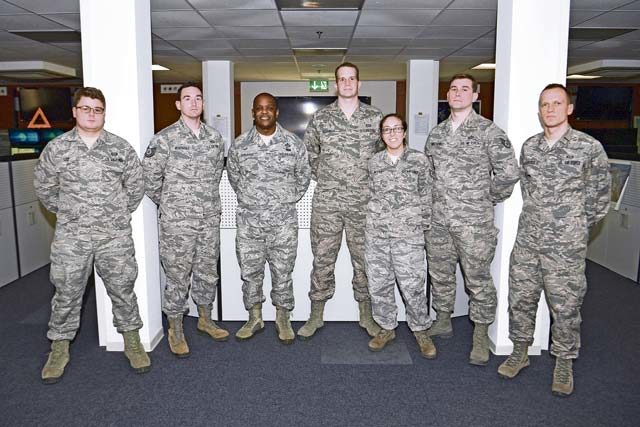
Planning for operations in the military takes information from multiple sources including weather. When 4,000 troops were at risk due to a record-breaking storm, Airmen from the 21st Operational Weather Squadron sprang into action. They began tracking winter storm Friederike from infancy to a record storm persisting three days in northern Europe Jan. 17 to 19.
The 21st OWS observes and reports weather patterns for all of U.S. European Command and U.S. Africa Command. At any given time approximately 20 weather technicians are on watch.
“We started looking at this storm around 13 of January,” said 2nd Lt. Scott LaVoise, 21st OWS weather operations officer. “As it materialized, we issued the special weather statement giving all areas forecasted to be involved a heads up.”
Winter storm Friederike started leaving a path of destruction Jan. 17.
Maj. James Caldwell, 21st OWS operations officer, said the squadron makes sure the forecast is accurate and that it gets to the right people at the right time.
“We’re telling a story,” said Caldwell. “We try to paint the best picture in the commander’s mind and planner’s mind about what to anticipate two or three days out. That way they take environmental conditions in mind when they plan a mission.”
The 21st OWS identifies the importance of a storm based on how widespread the event is, how many installations will be affected, what kind of missions it can potentially impact, and the duration and intensity. Once the Airmen gather weather information and build the forecasts, they notify predetermined planners within each combatant command that could be potentially impacted.
“We can’t know every operation that goes on at each and every location, but we want to alert as many people as possible that hazardous weather is going to happen at a specific place and time,” said Caldwell.
Caldwell said the 21st OWS operates in a role similar to the national weather service and storm prediction center for the forces in Europe.
LaVoise said that during winter storm Friederike, Airmen were also keeping track of several lightning storms in the area.
“It was pretty hectic,” said LaVoise. “There were a lot of weather alerts we issued, a total of 38 wind watches and 58 warnings over the course of three days, which is a significant amount.”
Caldwell said that being able to issue a special weather statement between 48 and 72 hours before the event, is a good hit. The statement for storm Friederike was put out 60 hours before the first impacts were felt in Europe and actual weather events played out as initially forecasted.

As a result, Caldwell said, approximately 4,000 troops involved in a multi-national exercise who were in the path of the storm were moved to safety.
“We like to harmonize everyone’s talent in this unit, whether it’s our training team or the systems folks who provide our connectivity to the outside world,” said Caldwell. “Everyone teamed up on this one. It was up to the operational flights to keep the narrative going. Typically, when our ‘weather story’ needs to change, then it is up to that flight to give us a detailed update. That didn’t have to happen because everyone was in sync. It was a team effort from the entire squadron once we knew the forecast was accurate.”
Storm Friederike was labeled the worst storm in the last 11 years in Germany, and Caldwell said it was the kind of storm that comes around once in an Airman’s career.
“This event didn’t take much coaching or quarterbacking. Already seeing such a harsh winter, our Airmen were poised and ready. Watching our people instinctively over communicate and squeeze all the accuracy out of this building that we could, it was remarkable and a highlight of my time here at the unit,” said Caldwell. “This whole winter season has been intense. Our reaction to these hazards is a testament to the noncommissioned officers training our new Airmen on the ops floor, our training team and our leadership on the ops floor.”


